Discover 50 hidden attractions, cool sights, and unusual things to do in Israel. Don't miss out on these must-see attractions: Western Wall (Jerusalem), Yad Vashem (Jerusalem) or Temple Mount (Jerusalem).
Below, you can find the list of the most amazing places you should visit in Israel.
Table of Contents
Western Wall, Jerusalem
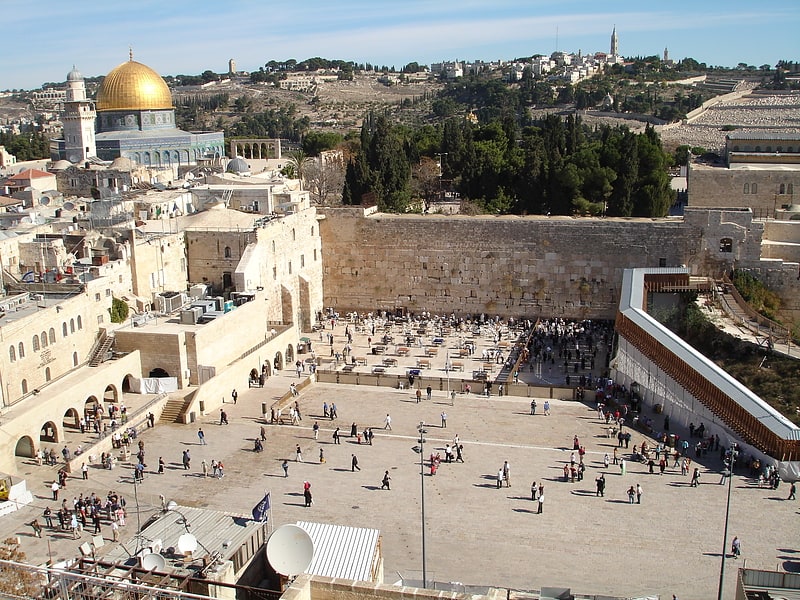
Also known as: הכותל המערבי
Ancient sacred site for Jewish prayer. The Wailing Wall or Western Wall, known in Islam as the Buraq Wall, is an ancient limestone wall in the Old City of Jerusalem. It is a relatively small segment of a far longer ancient retaining wall, known also in its entirety as the "Western Wall". The wall was originally erected as part of the expansion of the Second Jewish Temple begun by Herod the Great, which resulted in the encasement of the natural, steep hill known to Jews and Christians as the Temple Mount, in a huge rectangular structure topped by a flat platform, thus creating more space for the Temple itself, its auxiliary buildings, and crowds of worshipers and visitors.
In one of several varying Muslim traditions, it is the site where the Islamic Prophet Muhammad tied his winged steed, al-Buraq, on his Isra and Mi'raj to Jerusalem before ascending to paradise, and constitutes the western border of al-Haram al-Sharif, the Noble Sanctuary of the Al-Aqsa Mosque.
The Western Wall's holiness in Judaism is a result of its proximity to the Temple Mount. Because of the Temple Mount entry restrictions, the Wall is the holiest place where Jews are permitted to pray, though the site of the Holy of Holies, the most sacred site in the Jewish faith, lies behind it. The original, natural, and irregular-shaped Temple Mount was gradually extended to allow for an ever-larger Temple compound to be built at its top. This process was finalized by Herod, who enclosed the Mount with an almost rectangular set of retaining walls, made to support the Temple platform and using extensive substructures and earth fills to give the natural hill a geometrically regular shape. On top of this box-like structure, Herod built a vast paved platform that surrounded the Temple. Of the four retaining walls, the western one is considered closest to the former Holy of Holies, which makes it the most sacred site recognized by Judaism outside the previous Temple Mount platform.
Just over half the wall's total height, including its 17 courses located below street level, dates from the end of the Second Temple period, and is commonly believed to have been built by Herod the Great starting in 19 BCE, although recent excavations indicate that the work was not finished by the time Herod died in 4 BCE. The very large stone blocks of the lower courses are Herodian, the courses of medium-sized stones above them were added during the Umayyad period, while the small stones of the uppermost courses are of more recent date, especially from the Ottoman period.
The term Western Wall and its variations are mostly used in a narrow sense for the section traditionally used by Jews for prayer; it has also been called the "Wailing Wall", referring to the practice of Jews weeping at the site over the destruction of the Temples. During the period of Christian Roman rule over Jerusalem (ca. 324–638), Jews were completely barred from Jerusalem except on Tisha B'Av, the day of national mourning for the Temples, and on this day the Jews would weep at their holy places. The term "Wailing Wall" was thus almost exclusively used by Christians, and was revived in the period of non-Jewish control between the establishment of British Rule in 1920 and the Six-Day War in 1967. The term "Wailing Wall" is not used by religious Jews, and increasingly not by many others who consider it derogatory.
In a broader sense, "Western Wall" can refer to the entire 488-metre-long (1,601 ft) retaining wall on the western side of the Temple Mount. The classic portion now faces a large plaza in the Jewish Quarter, near the southwestern corner of the Temple Mount, while the rest of the wall is concealed behind structures in the Muslim Quarter, with the small exception of an 8-metre (26 ft) section, the so-called Little Western Wall. The segment of the western retaining wall traditionally used for Jewish liturgy, known as the "Western Wall" or "Wailing Wall", derives its particular importance to it having never been fully obscured by medieval buildings, and displaying much more of the original Herodian stonework than the "Little Western Wall". In religious terms, the "Little Western Wall" is presumed to be even closer to the Holy of Holies and thus to the "presence of God" (Shechina), and the underground Warren's Gate, which has been out of reach for Jews from the 12th century till its partial excavation in the 20th century, even more so.
Whilst the wall was considered Muslim property as an integral part of the Haram esh-Sharif and waqf property of the Moroccan Quarter, a right of Jewish prayer and pilgrimage existed as part of the Status Quo. This position was confirmed in a 1930 international commission during the British Mandate period.
The earliest source mentioning this specific site as a place of Jewish worship is from the 17th century. The previous sites used by Jews for mourning the destruction of the Temple, during periods when access to the city was prohibited to them, lay to the east, on the Mount of Olives and in the Kidron Valley below it. From the mid-19th century onwards, attempts to purchase rights to the wall and its immediate area were made by various Jews, but none was successful. With the rise of the Zionist movement in the early 20th century, the wall became a source of friction between the Jewish and Muslim communities, the latter being worried that the wall could be used to further Jewish claims to the Temple Mount and thus Jerusalem. During this period outbreaks of violence at the foot of the wall became commonplace, with a particularly deadly riot in 1929 in which 133 Jews and 116 Arabs were killed, with many more people injured. After the 1948 Arab–Israeli War the eastern portion of Jerusalem was occupied by Jordan. Under Jordanian control Jews were completely expelled from the Old City including the Jewish Quarter, and Jews were barred from entering the Old City for 19 years, effectively banning Jewish prayer at the site of the Western Wall. This period ended on June 10, 1967, when Israel gained control of the site following the Six-Day War. Three days after establishing control over the Western Wall site, the Moroccan Quarter was bulldozed by Israeli authorities to create space for what is now the Western Wall plaza.[1]
Address: Western Wall Plaza, 97500 Jerusalem
Yad Vashem, Jerusalem

Also known as: יד ושם
Holocaust memorial and education center. Yad Vashem is Israel's official memorial to the victims of the Holocaust. It is dedicated to preserving the memory of the Jews who were murdered; honoring Jews who fought against their Nazi oppressors and Gentiles who selflessly aided Jews in need; and researching the phenomenon of the Holocaust in particular and genocide in general, with the aim of avoiding such events in the future.
Established in 1953, Yad Vashem is located on the western slope of Mount Herzl, also known as the Mount of Remembrance, a height in western Jerusalem, 804 meters (2,638 ft) above sea level and adjacent to the Jerusalem Forest. The memorial consists of a 180-dunam (18.0 ha; 44.5-acre) complex containing two types of facilities: some dedicated to the scientific study of the Holocaust and genocide in general, and memorials and museums catering to the needs of the larger public. Among the former there are a research institute with archives, a library, a publishing house, and an educational center, and the International School for Holocaust Studies; among the latter, the Holocaust History Museum, memorial sites such as the Children's Memorial and the Hall of Remembrance, the Museum of Holocaust Art, sculptures, outdoor commemorative sites such as the Valley of the Communities, and a synagogue.
A core goal of Yad Vashem's founders was to recognize non-Jews who, at personal risk and without a financial or evangelistic motive, chose to save Jews from the ongoing genocide during the Holocaust. Those recognized by Israel as Righteous Among the Nations are honored in a section of Yad Vashem known as the Garden of the Righteous Among the Nations.
Yad Vashem is the second-most-visited Israeli tourist site, after the Western Wall, with approximately one million visitors each year. It charges no admission fee.[2]
Address: Har Hazikaron, P.O.B. 3477, 91034 שלם
Temple Mount, Jerusalem

Also known as: הר הבית
Hilltop compound of religious sites. The Temple Mount, known to Muslims as the Haram esh-Sharif and the Al-Aqsa Compound, is a hill in the Old City of Jerusalem that for thousands of years has been venerated as a holy site in Judaism, Christianity, and Islam alike.
The present site is a flat plaza surrounded by retaining walls (including the Western Wall) that was built during the reign of Herod the Great for an expansion of the temple. The plaza is dominated by three monumental structures from the early Umayyad period – the al-Aqsa Mosque, the Dome of the Rock and the Dome of the Chain – and four minarets. Herodian walls and gates, with additions from the late Byzantine and early Islamic periods, cut through the flanks of the Mount. Currently, it can be reached through eleven gates, ten reserved for Muslims and one for non-Muslims, with guard posts of Israeli police in the vicinity of each.
According to Jewish tradition and scripture, the First Temple was built by King Solomon, the son of King David, in 957 BCE, and was destroyed by the Neo-Babylonian Empire in 586 BCE; however, no substantial archaeological evidence has verified this. The Second Temple was constructed under the auspices of Zerubbabel in 516 BCE, and was destroyed by the Roman Empire in 70 CE. Orthodox Jewish tradition maintains it is here that the third and final Temple will be built when the Messiah comes. The Temple Mount is the holiest site in Judaism, and is the place Jews turn towards during prayer. Due to its extreme sanctity, many Jews will not walk on the Mount itself, to avoid unintentionally entering the area where the Holy of Holies stood, since according to rabbinical law, there is still some aspect of the divine presence at the site.
Among Muslims, the Mount is the site of one of the three Sacred Mosques, the holiest sites in Islam. Amongst Sunni Muslims, it is considered the third holiest site in Islam. Revered as the Noble Sanctuary, the location of Muhammad's journey to Jerusalem and ascension to heaven, the site is also associated with the Jewish biblical prophets who are also venerated in Islam. Umayyad Caliphs commissioned the construction of the al-Aqsa Mosque and Dome of the Rock on the site. The Dome was completed in 692 CE, making it one of the oldest extant Islamic structures in the world. The Al Aqsa Mosque rests on the far southern side of the Mount, facing Mecca. The Dome of the Rock currently sits in the middle, occupying or close to the area where the Holy Temple previously stood.
In light of the dual claims of Judaism and Islam, it is one of the most contested religious sites in the world. Since the Crusades, the Muslim community of Jerusalem has managed the site through the Jerusalem Islamic Waqf. The Temple Mount is within the Old City, which has been controlled by Israel since 1967. After the Six-Day War, Israel handed administration of the site back to the Waqf under Jordanian custodianship, while maintaining Israeli security control. It remains a major focal point of the Arab–Israeli conflict. In an attempt to keep the status quo, the Israeli government enforces a controversial ban on prayer by non-Muslims.[3]
Kings City, Eilat
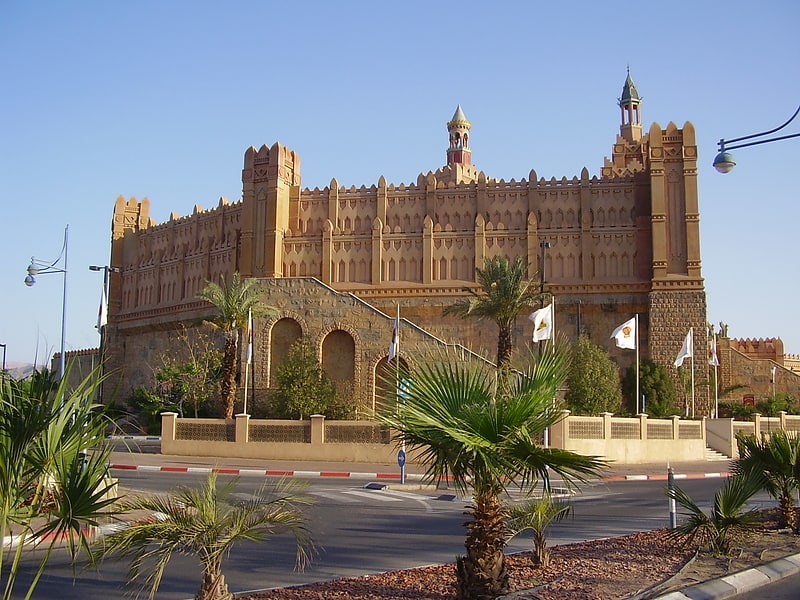
Also known as: עיר המלכים
Theme park in Eilat, Israel. Kings City was a biblical theme park in Eilat, Israel, which was inaugurated in June 2005. It is owned by "Africa Israel", "Elran d.d. Real Estate ltd" and a Swiss investor. The park could handle 4500 visitors per day. It closed in June 2015.[4]
Address: East Lagoon, 88000 Eilat
Dizengoff Street, Tel Aviv

Also known as: רחוב דיזנגוף
Street in Tel Aviv, Israel. Dizengoff Street is a major street in central Tel Aviv, named after Tel Aviv's first mayor, Meir Dizengoff.
The street runs from the corner of Ibn Gabirol Street in its southernmost point to the port area of Tel Aviv in its northwestern point. Dizengoff Street is one of the most important streets in Tel Aviv, and has played an essential role in the development of the city. Since the 1970s, Dizengoff Street has suffered urban decay.[5]
Address: Dizengoff St, Tel Aviv
Dizengoff Center, Tel Aviv
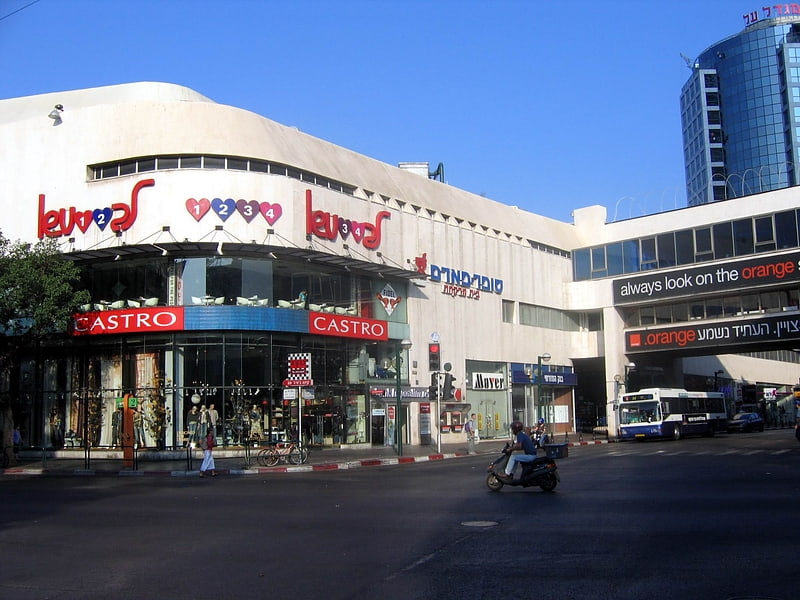
Also known as: דיזנגוף סנטר
Shopping mall in Tel Aviv, Israel. Dizengoff Center is a shopping mall at the intersection of Dizengoff Street and King George Street in Tel Aviv, Israel. The mall is named for Meir Dizengoff, the first mayor of Tel Aviv.[6]
Address: 50 Dizengoff St., 6433222 תל אביב-יפו
Ramat Gan Safari, Tel Aviv
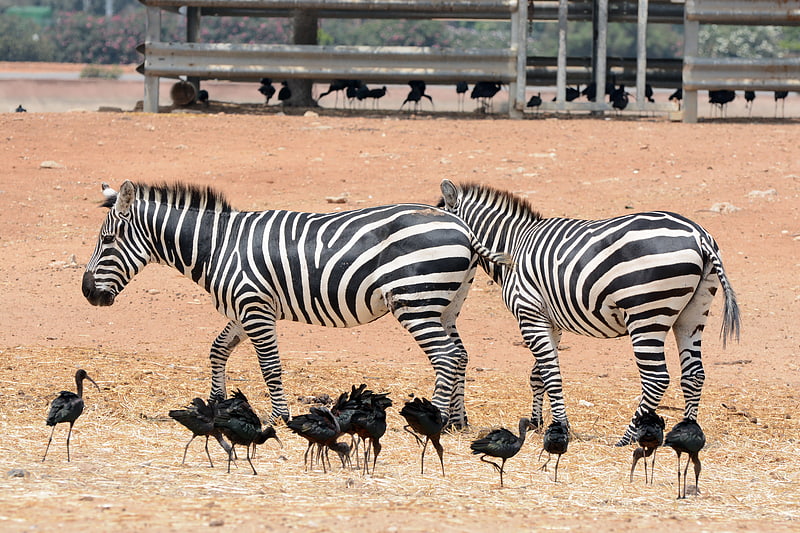
Also known as: הספארי ברמת גן
Zoo known for its drive-thru animal park. The Zoological Center Tel Aviv-Ramat Gan in the Tel Aviv District city of Ramat Gan, Israel is the largest collection of wildlife in human care in the Middle East. The 250-acre site consists of both a drive-through African safari area and a modern outdoor zoo. The African animal park opened to the general public in 1974. In 1981, the zoo was established in the middle of the park to replace the Tel Aviv Zoo, which had closed down.
Ramat Gan Safari houses 83 species of mammals, 92 species of birds and 23 species of reptiles. Among other outstanding groups of animals, it has white rhinos, hippos, lions, African and Asian elephants, gorillas, orangutans, and a Komodo dragon. The animals are seen in open air enclosures amid subtropical gardens.
The Ramat Gan Safari has sent animals to the Qalqilya Zoo in the West Bank of the Palestinian territories and maintains close ties with the veterinarians in the Palestinian Authority.
It has more than 700,000 visitors annually from all social and ethnic groups of Israel as well as tourists from abroad.[7]
Address: Hatsfi Avenue, Tel Aviv
Shrine of the Báb, Haifa
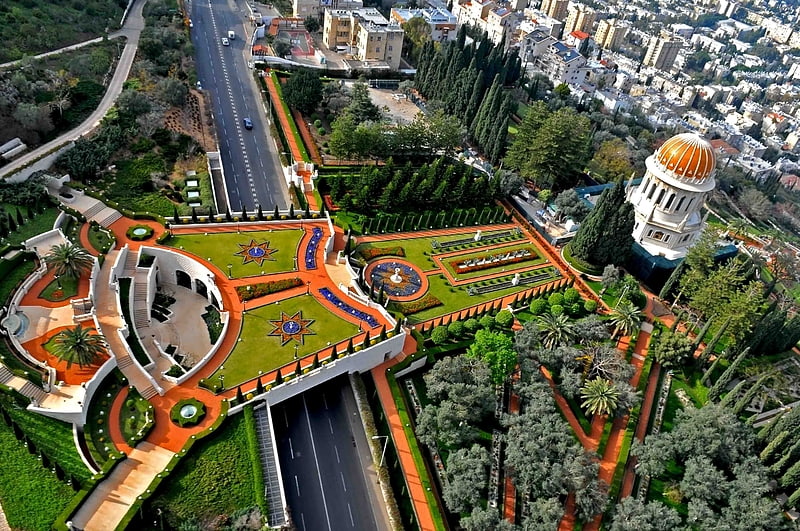
Also known as: מקדש הבאב
Domed-shaped edifice with sacred remains. The Shrine of the Báb is a structure on the slopes of Mount Carmel in Haifa, Israel, where the remains of the Báb, founder of the Bábí Faith and forerunner of Baháʼu'lláh in the Baháʼí Faith, are buried; it is considered to be the second holiest place on Earth for Baháʼís, after the Shrine of Baháʼu'lláh in Acre. Its precise location on Mount Carmel was designated by Baháʼu'lláh himself to his eldest son, ʻAbdu'l-Bahá, in 1891. ʻAbdu'l-Bahá planned the structure, which was designed and completed several years later by his grandson, Shoghi Effendi.
Crowning the design, as anticipated by ʻAbdu'l-Bahá, is a dome, which is set on an 18-windowed drum. That, in turn, is mounted on an octagon, a feature suggested by Shoghi Effendi. An arcade surrounds the stone edifice. A restoration project of the exterior and interior of the shrine started in 2008 and was completed in April 2011.[8]
Madatech, Haifa

Also known as: מדעטק - המוזיאון הלאומי למדע, טכנולוגיה וחלל
Museum in Haifa, Israel. The Israel National Museum of Science, Technology, and Space is a science and technology museum in the city of Haifa, Israel. The museum has approximately 200,000 visitors annually.[9]
Address: Rehov Balfour 25, 3144801 Haifa
Church of the Nativity, Bethlehem
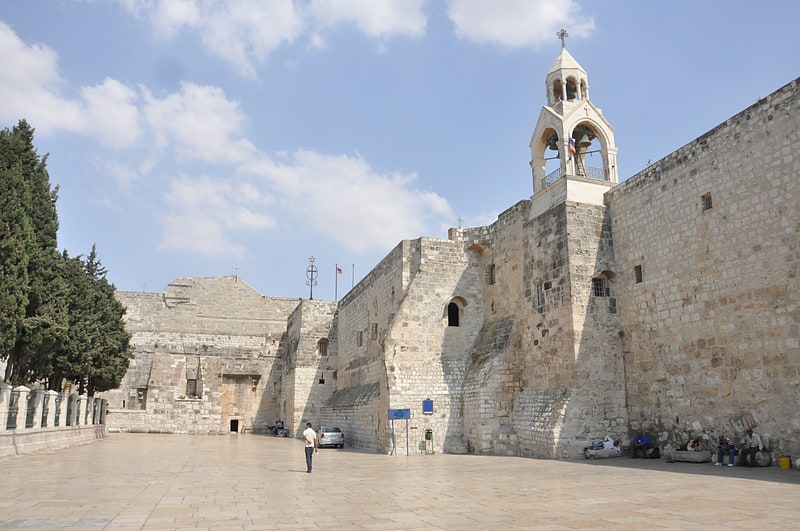
Also known as: כנסיית המולד
Storied, ancient 4th-century church. The Church of the Nativity, or Basilica of the Nativity, is a basilica located in Bethlehem in the West Bank, Palestine. The grotto it contains holds a prominent religious significance to Christians of various denominations as the birthplace of Jesus. The grotto is the oldest site continuously used as a place of worship in Christianity, and the basilica is the oldest major church in the Holy Land.
The church was originally commissioned by Constantine the Great a short time after his mother Helena's visit to Jerusalem and Bethlehem in 325–326, on the site that was traditionally considered to be the birthplace of Jesus. That original basilica was likely built between 330 and 333, being already mentioned in 333, and was dedicated on 31 May 339. It was destroyed by fire during the Samaritan revolts of the sixth century, possibly in 529, and a new basilica was built a number of years later by Byzantine Emperor Justinian (r. 527–565), who added a porch or narthex, and replaced the octagonal sanctuary with a cruciform transept complete with three apses, but largely preserved the original character of the building, with an atrium and a basilica consisting of a nave with four side aisles.
The Church of the Nativity, while remaining basically unchanged since the Justinianic reconstruction, has seen numerous repairs and additions, especially from the Crusader period, such as two bell towers (now gone), wall mosaics and paintings (partially preserved). Over the centuries, the surrounding compound has been expanded, and today it covers approximately 12,000 square meters, comprising three different monasteries: one Roman Catholic, one Armenian Apostolic, and one Greek Orthodox, of which the first two contain bell towers built during the modern era.
The silver star marking the spot where Christ was born, inscribed in Latin, was stolen in October 1847 by Greek monks who wished to remove this Catholic item. Some assert that this was a contributing factor in the Crimean War against the Russian Empire. Others assert that the war grew out of the wider European situation.
Since 2012, the Church of the Nativity is a World Heritage Site and was the first to be listed by UNESCO under 'Palestine'.
A 250-year-old understanding among religious communities, the Status Quo, applies to the site.[10]
Address: Manger Sq., Bethlehem
Aquarium, Eilat
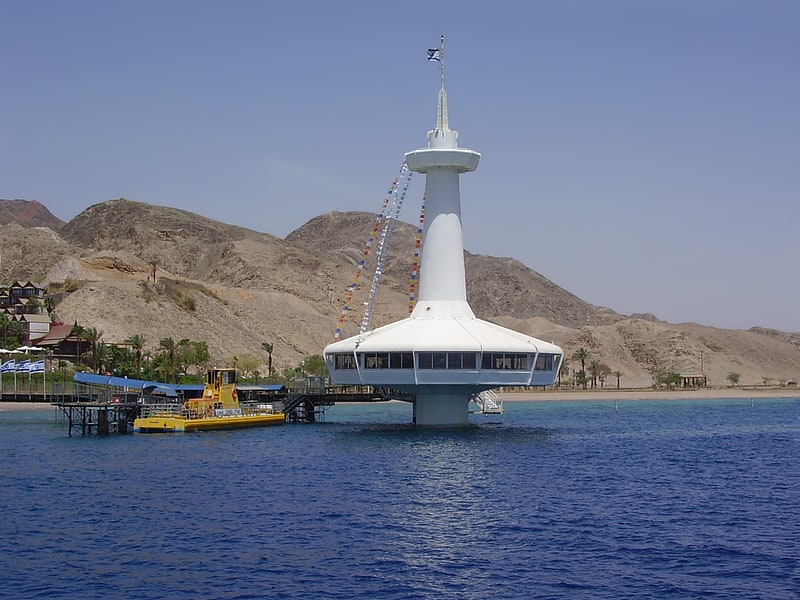
Also known as: פארק המצפה התת-ימי באילת
Aquarium in Eilat, Israel. Eilat's Coral World Underwater Observatory is a public aquarium, park and conservation center located in Eilat, Israel. It is the biggest public aquarium in Israel, and it hosts over 800 species. It was founded in 1974 and was the first of its kind. The park and aquarium is located to the south of Eilat's Coral Beach nature reserve.[11]
Address: Highway 90, 88106 Eilat
Universal House of Justice, Haifa
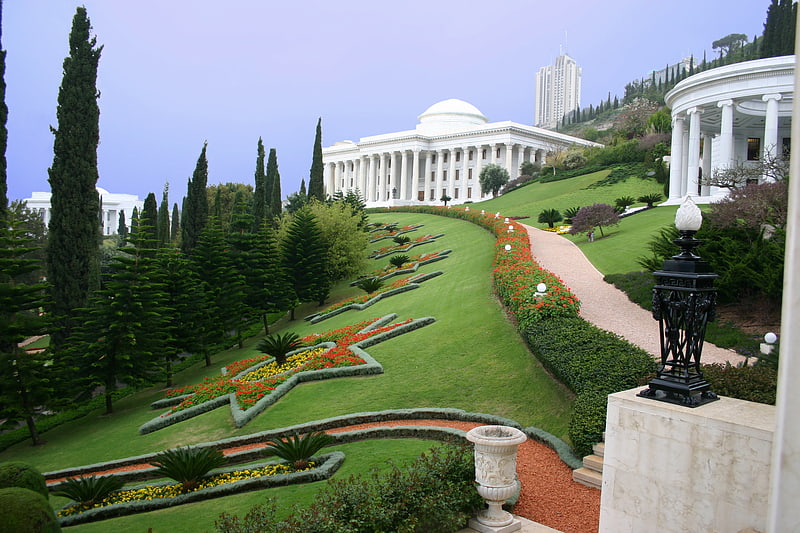
Also known as: בית הצדק העולמי
The Universal House of Justice is the nine-member supreme ruling body of the Baháʼí Faith. It was envisioned by Baháʼu'lláh, the founder of the Baháʼí Faith, as an institution that could legislate on issues not already addressed in the Baháʼí writings, providing flexibility for the Baháʼí Faith to adapt to changing conditions. It was first elected in 1963, and subsequently every five years, by delegates consisting of the members of Baháʼí National Spiritual Assemblies throughout the world.
The Universal House of Justice, as the head of the religion, has provided direction to the worldwide Baháʼí community primarily through a series of multi-year plans, as well as through annual messages delivered during the Ridván festival. The messages have focused on increasing the number of Local Spiritual Assemblies, translating Baháʼí literature, establishing Baháʼí Centres, completing Baháʼí Houses of Worship, holding international conferences, and developing educational systems to enhance literacy, the role of women, spirituality for children and youth, family life, social and economic development, and communal worship. The Universal House of Justice has also played a role in responding to systemic persecution of Baháʼís in Iran by garnering worldwide media attention.
The books and documents published by the Universal House of Justice are considered authoritative and its legislative decisions are considered infallible by Baháʼís. Although it is empowered to legislate on matters that are not addressed in the Baha'i holy writings, the Universal House of Justice has rarely exercised this function.
The Seat of the Universal House of Justice and its members reside in Haifa, Israel, on the slope of Mount Carmel. The most recent election was 29 April 2018. Although all other elected and appointed roles in the Baháʼí Faith are open to men and women, membership on the Universal House of Justice is male-only; the Baháʼí writings indicate that the reason for this will become clear in the future.[12]
Address: 61 Yefe Nof, 3464701 Haifa
Tel Megiddo, Nazareth

Also known as: תל מגידו
Protected site. Tel Megiddo is the site of the ancient city of Megiddo, the remains of which form a tell, situated in northern Israel near Kibbutz Megiddo, about 30 km south-east of Haifa. Megiddo is known for its historical, geographical, and theological importance, especially under its Greek name Armageddon. During the Bronze Age, Megiddo was an important Canaanite city-state and during the Iron Age, a royal city in the Kingdom of Israel.
Megiddo drew much of its importance from its strategic location at the northern end of the Wadi Ara defile, which acts as a pass through the Carmel Ridge, and from its position overlooking the rich Jezreel Valley from the west.
Excavations have unearthed 20 strata of ruins since the Neolithic phase, indicating a long period of settlement. The site is now protected as Megiddo National Park and is a World Heritage Site.[13]
Taba Border Crossing, Eilat

Also known as: מעבר מנחם בגין
The Taba Border Crossing also known as the Menachem Begin Crossing is an international border crossing between Taba, Egypt, and Eilat, Israel[14]
Basilica of the Annunciation, Nazareth
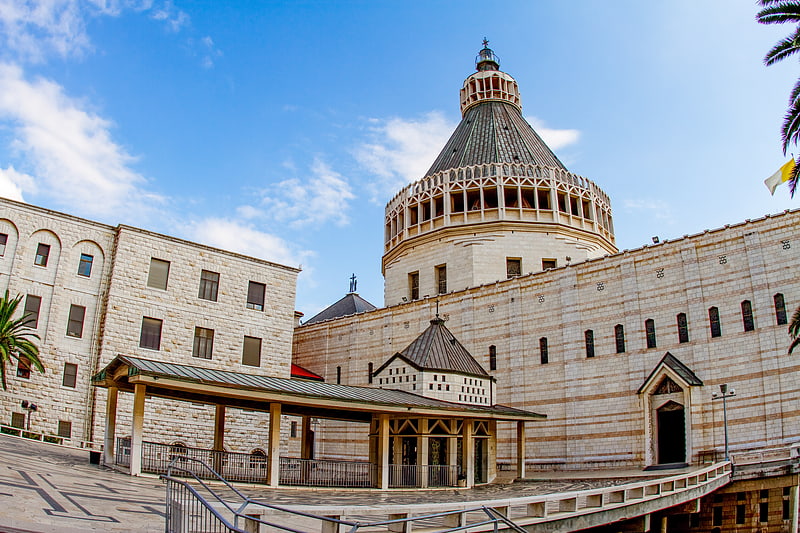
Also known as: כנסיית הבשורה
Church on the site of the Annunciation. This article refers to the basilica in Nazareth. For information on the church associated with the Blagoveschenskaya Tower in Russia, see Kremlin towers or Cathedral of the Annunciation.
The Church of the Annunciation, sometimes also referred to as the Basilica of the Annunciation, is a Catholic church in Nazareth, in northern Israel. It was established over what Catholic tradition holds to be the site of the house of the Virgin Mary, and where the angel Gabriel appeared to her and announced that she would conceive and bear the Son of God, Jesus – an event known as the Annunciation.[15]
Address: Casa Nova Street, Nazareth
Sea of Galilee, Tiberias
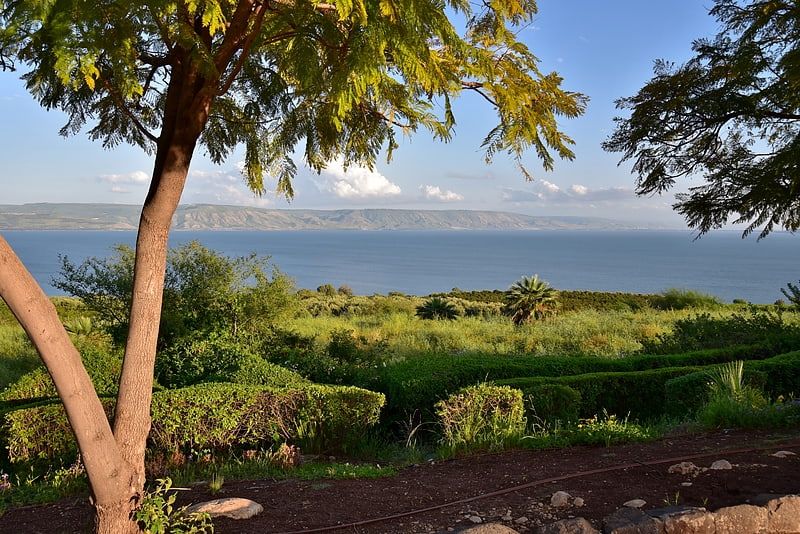
Also known as: הכנרת
Lake popular with Christian pilgrims. The Sea of Galilee, also called Lake Tiberias, Kinneret or Kinnereth, is a freshwater lake in Israel. It is the lowest freshwater lake on Earth and the second-lowest lake in the world, at levels between 215 metres and 209 metres below sea level. It is approximately 53 km in circumference, about 21 km long, and 13 km wide. Its area is 166.7 km2 at its fullest, and its maximum depth is approximately 43 metres. The lake is fed partly by underground springs but its main source is the Jordan River, which flows through it from north to south and exits the lake at the Degania Dam.[16]
Cave of the Patriarchs, Hebron

Also known as: מערת המכפלה
Mosque in Hebron. The Cave of the Patriarchs or Tomb of the Patriarchs, known to Jews as the Cave of Machpelah and to Muslims as the Sanctuary of Abraham, is a series of caves situated 30 kilometres south of Jerusalem in the heart of the Old City of Hebron in the West Bank. According to the Abrahamic religions, the cave and adjoining field were purchased by Abraham as a burial plot, although most historians believe the Abraham-Isaac-Jacob narrative to be primarily mythological.
Over the cave stands a large rectangular enclosure dating from the Herodian era. During Byzantine rule of the region, a basilica was built on the site; the structure was converted into the Ibrahimi Mosque following the Muslim conquest of the Levant. By the 12th century, the mosque and its surrounding regions had fallen under Crusader-state control, but were retaken in 1188 by the Ayyubid sultan Saladin, who again converted the structure into a mosque.
During the Six-Day War of 1967, the entire Jordanian-occupied West Bank was seized and occupied by the State of Israel, after which the structure was divided into a synagogue and a mosque. In 1968, a special arrangement was made to accommodate Jewish services on the Jewish New Year and Day of Atonement, leading to a hand-grenade attack on 9 October which injured 47 Israelis; and a second bombing on 4 November, which wounded 6 people. Further attacks occurred on Yom Kippur eve in 1976, when an Arab mob destroyed several Torah scrolls and prayer books at the tomb, and in May 1980, when an attack on Jewish worshippers returning from prayers at the tomb left 6 dead and 17 wounded. In 1994, the Cave of the Patriarchs massacre occurred at the Ibrahimi Mosque, in which an armed Israeli settler entered the complex on the Jewish holiday of Purim—which had occurred during the Islamic holy month of Ramadan—and opened fire on Palestinian Muslims who had gathered to pray at the site, killing 29 people, including children, and wounding over 125.
The site is considered to be the second-holiest place in Judaism, after the Temple Mount in the Old City of Jerusalem.[17]
Address: Old Hebron, 90100 Hebron
Mar Saba, Bethlehem
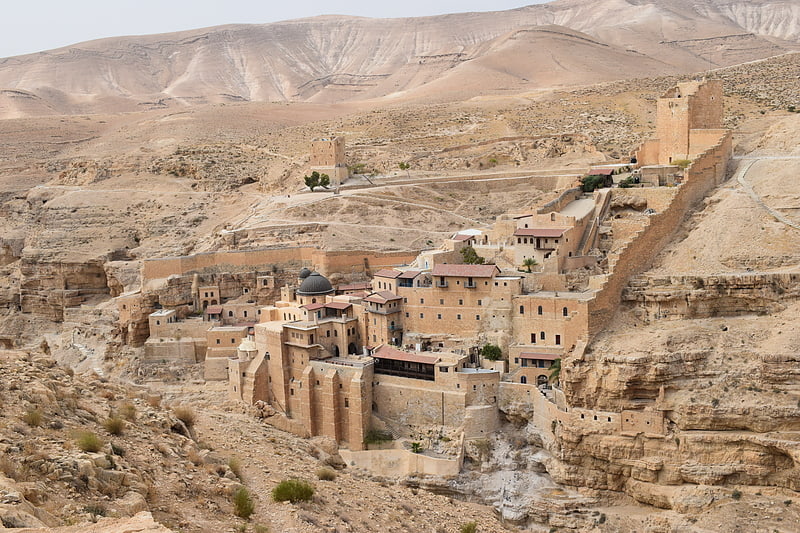
Also known as: מנזר מר סבא
Monastery. The Holy Lavra of Saint Sabbas, known in Arabic and Syriac as Mar Saba and historically as the Great Laura of Saint Sabas, is a Greek Orthodox monastery overlooking the Kidron Valley in the Bethlehem Governorate of Palestine, in the West Bank, at a point halfway between Bethlehem and the Dead Sea. The monks of Mar Saba and those of subsidiary houses are known as Sabaites.
Mar Saba is considered to be one of the oldest continuously inhabited monasteries in the world, and it maintains many of its ancient traditions. One in particular is the restriction on women entering the main compound. The only building that women can enter is the Women's Tower, near the main entrance.[18]
Address: Juda Desert, Bethlehem
Rachel's Tomb, Bethlehem
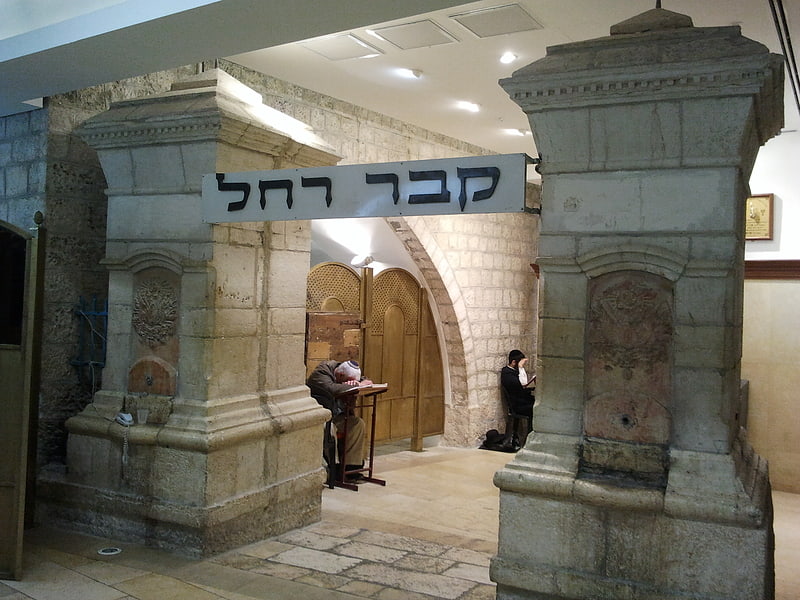
Also known as: קבר רחל
Place of worship. Rachel's Tomb is the site revered as the burial place of the matriarch Rachel. The site is also referred to as the Bilal bin Rabah mosque. The tomb is held in esteem by Jews, Christians, and Muslims.
The tomb, located at the northern entrance of Bethlehem, is built in the style of a traditional maqam; Arabic for shrine. The burial place of the matriarch Rachel as mentioned in the Jewish Tanakh, the Christian Old Testament and in Muslim literature is contested between this site and several others to the north. Although this site is considered unlikely to be the actual site of the grave, it is by far the most recognized candidate.
The earliest extra-biblical records describing this tomb as Rachel's burial place date to the first decades of the 4th century CE. The structure in its current form dates from the Ottoman period, and is situated in a Christian and Muslim cemetery dating from at least the Mamluk period. When Sir Moses Montefiore renovated the site in 1841 and obtained the keys for the Jewish community, he also added an antechamber, including a mihrab for Muslim prayer, to ease Muslim fears. According to the 1947 United Nations Partition Plan for Palestine, the tomb was to be part of the internationally administered zone of Jerusalem, but the area was ruled by Jordan, which prohibited Jews from entering the area. Following the Israeli occupation of the West Bank in 1967, though not initially falling within Area C, the site has come under the control of the Israeli Ministry of Religious Affairs.
Following Montefiore's purchase of the site it began to take special "cultic" significance amongst Jews in the area; in contemporary Israeli society it is now considered the third holiest site in Judaism and has become one of the cornerstones of Jewish-Israeli identity. According to Genesis 35:20, a mazzebah was erected at the site of Rachel's grave in ancient Israel, leading scholars to consider the site to have been a place of worship in ancient Israel. According to Martin Gilbert, Jews have made pilgrimage to the tomb since ancient times. According to Frederick Strickert, the first historically recorded pilgrimages to the site were by early Christians, and Christian witnesses wrote of the devotion shown to the shrine "by local Muslims and then later also by Jews"; throughout history, the site was rarely considered a shrine exclusive to one religion and is described as being "held in esteem equally by Jews, Muslims, and Christians".
Following a 1929 British memorandum, in 1949 the UN ruled that the Status Quo, an arrangement approved by the 1878 Treaty of Berlin concerning rights, privileges and practices in certain Holy Places, applies to the site. In 2005, following Israeli approval on 11 September 2002, the Israeli West Bank barrier was built around the tomb, effectively annexing it to Jerusalem; Checkpoint 300 – also known as Rachel's Tomb Checkpoint – was built adjacent to the site. A 2005 report from OHCHR Special Rapporteur John Dugard noted that: "Although Rachel's Tomb is a site holy to Jews, Muslims and Christians, it has effectively been closed to Muslims and Christians." On October 21, 2015, UNESCO adopted a resolution reaffirming a 2010 statement that Rachel's Tomb was: "an integral part of Palestine." On 22 October 2015, the tomb was separated from Bethlehem with a series of concrete barriers.[19]
Avshalom Cave, Beit Shemesh
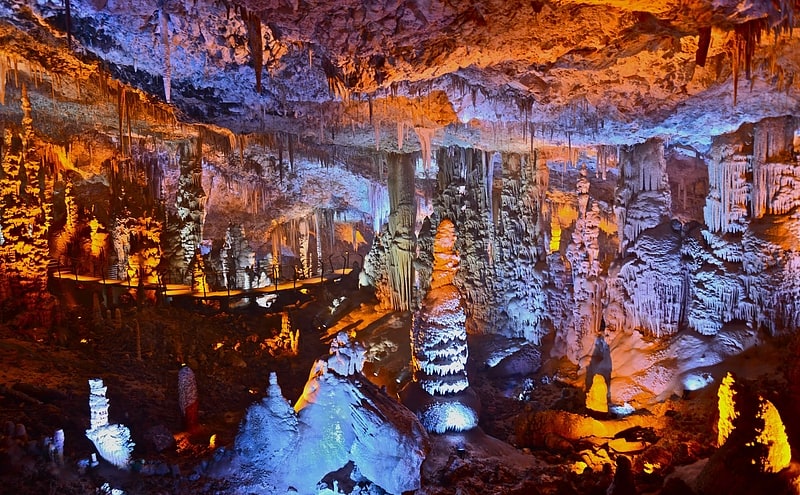
Also known as: מערת הנטיפים
Cave in Israel. Avshalom Cave, known in academic literature as Soreq Cave, Arabic: مغارة سوريك, romanized: Mghar Suriq) an popularly as Stalactites Cave, is a 5,000 m2 cave on the western side of Mt. Ye'ela, in the Judean hills in Israel, unique for its dense concentration of stalactites and other cave formations.
The cave has been the focus of paleoclimate research, which allowed reconstruction of the region's semi-arid climate for the past 185,000 years. According to the American geologist James Aronson, the Soreq Cave Nature Reserve is the Rosetta stone of climate history in the Eastern Mediterranean.[20]
El-Jazzar Mosque, Akko
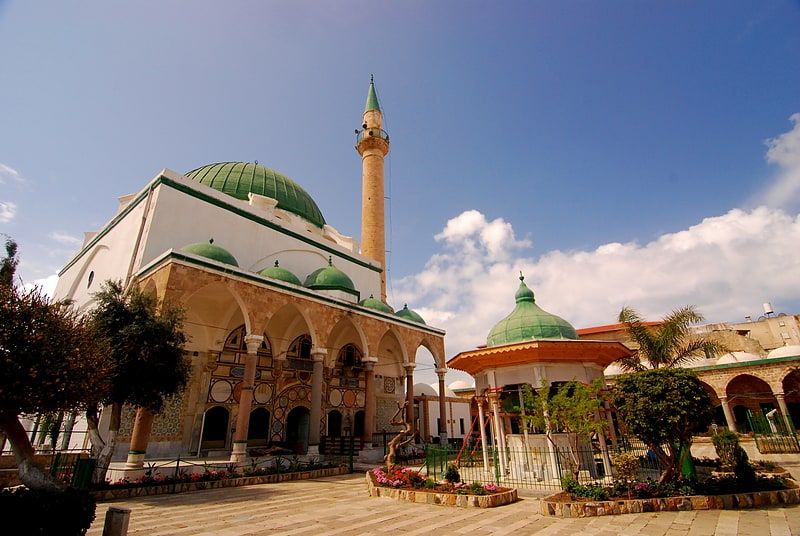
Also known as: מסגד אל-ג'זאר
Grand 18th-century mosque with sea views. The el-Jazzar Mosque, also known as the White Mosque, is located on el-Jazzar Street inside the walls of the old city of Acre, overlooking the eastern Mediterranean Sea, and is named after the Ottoman Bosnian governor Ahmad Pasha el-Jazzar.[21]
Address: Al-Jazzar st, Old Acre, 24100 Acre
Khan al-Umdan, Akko
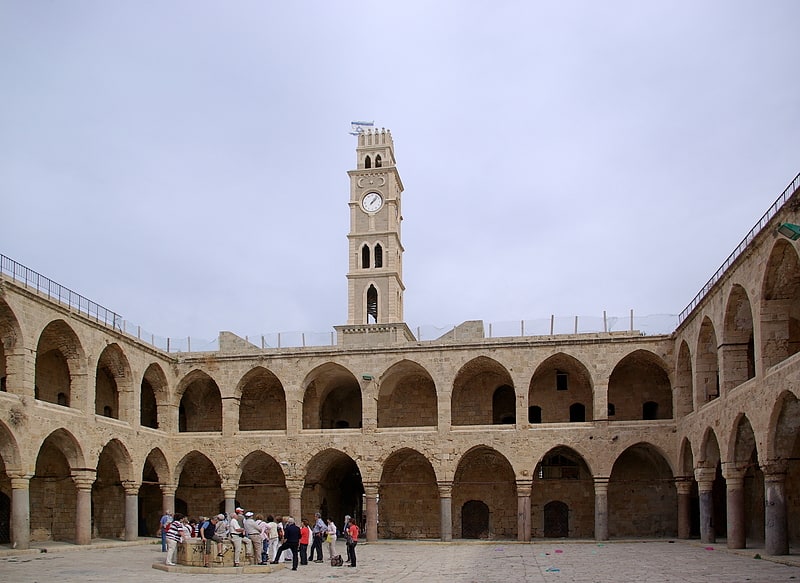
Also known as: חאן אל-עומדאן
Historical landmark in Acre, Israel. Khan al-Umdan is the largest and best preserved caravanserai in Acre, Israel. Located in the Old City of Acre, it is one of the prominent projects constructed during the rule of Ahmed Jezzar Pasha in Galilee, under the Ottoman era.[22]
Greek Orthodox Church of the Annunciation, Nazareth

Also known as: כנסיית גבריאל הקדוש
Landmark church with subterranean chapel. The Greek Orthodox Church of the Annunciation, also known as the Greek Orthodox Church of Saint Gabriel, is an Eastern Orthodox church in Nazareth, Israel. Likely first established in Byzantine-era Palaestina Prima, it was rebuilt during the time of the Crusades, and again in the 18th century under the rule of Zahir al-Umar, the Arab governor of the Galilee.
Known colloquially among the Greek Orthodox worshippers of Galilee whom it serves as Kniset el-Rûm, or Church of the Eastern Romans in Levantine Arabic, the church is located over an underground spring, which according to Eastern Orthodox belief is where the Virgin Mary was drawing water at the time of the Annunciation. Water from the spring still runs inside the apse of the church and also fed the adjacent site of Mary's Well, located 150 yards (140 m) away.[23]
Domus Galilaeae, Tiberias

Also known as: דומוס גלילאה
Religious destination in Israel. Domus Galilaeae or House of Galilee, located on the peak of Mount of Beatitudes, above and north of Capernaum and the Sea of Galilee, is a Christian meeting place used for seminars and conventions, run by the Neocatechumenal Way. On his pilgrimage to Israel in 2000, Pope John Paul II visited Domus Galilaeae and said he hoped it would become a place for interreligious dialogue.[24]
Address: Road #90 opposite Vered Hagalil, Tiberias
Akko Light, Akko

Also known as: מגדלור עכו
Lighthouse. Akko Light or Acre Light, is an active lighthouse in the port of Acre, Israel. It is located on the South-West corner of the city's ancient walls, at what is believed to be the former site of an Ottoman Burj-El-Sanjak.[25]
Israeli Air Force Museum, Beer Sheva
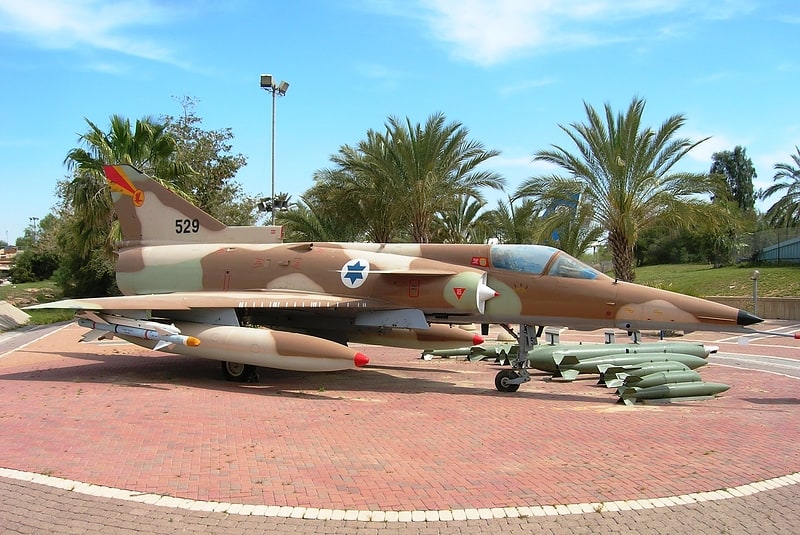
Also known as: מוזיאון חיל האוויר
Museum in Israel. The Israeli Air Force Museum is located at Hatzerim Airbase in the Negev desert.
The museum was established in 1977 and has been open to the public since 1991. The museum displays a variety of Israeli Air Force and foreign aircraft, as well as anti aircraft arms.[26]
Address: Bnei Shimon Regional Council, Beer Sheva
Museum of Philistine Culture, Ashdod
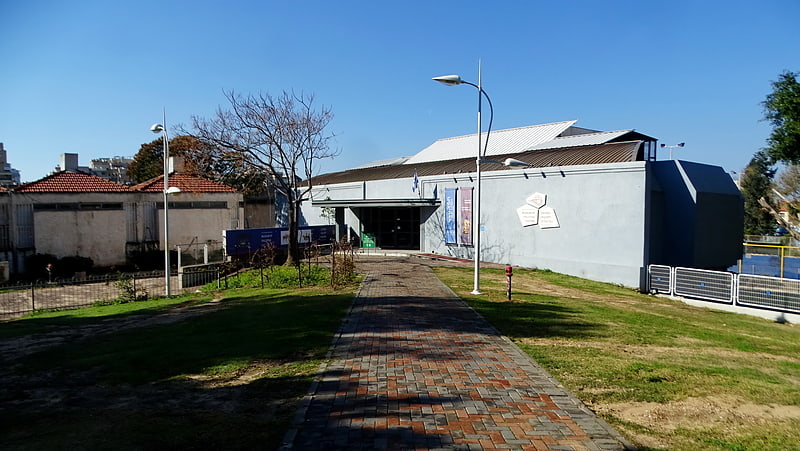
Museum in Ashdod, Israel. The Museum of Philistine Culture is an archaeological museum in Ashdod. The museum is dedicated to the culture of the Philistines, the ancient people who inhabited the maritime part of Israel from the XII century BC. It is the only museum in the world completely dedicated to the Philistine people.
The museum has a permanent exhibition showing archaeological finds, as well as temporary exhibitions. Cultural events are held for visitors; in particular, they can try on clothes similar to those worn by the ancient Philistines, and try the dishes of their cuisine.
In 1990, the Museum of Philistine Culture became the first museum to open in Ashdod.[27]
Address: 16 Ha-Shayatim, 7744100 Ashdod
Tel Be'er Sheva, Beer Sheva
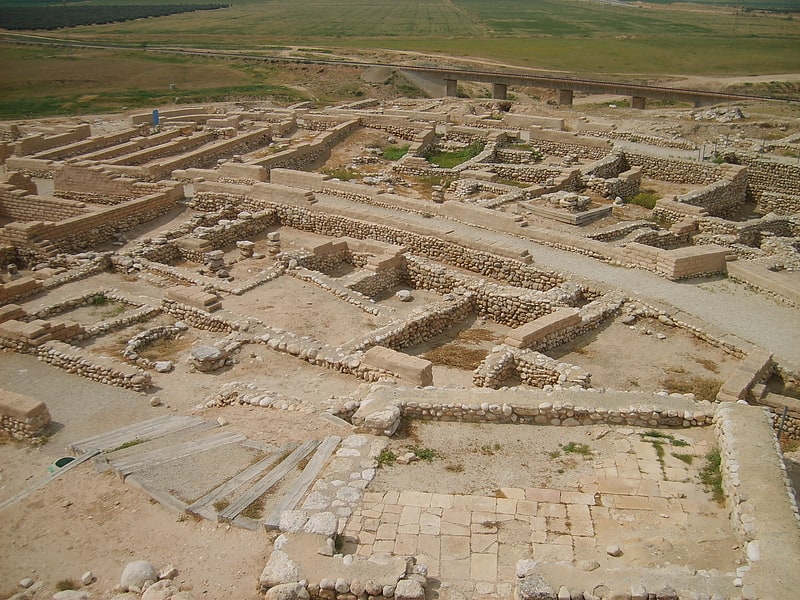
Also known as: תל באר שבע
National park in Beersheba, Israel. Tel Sheva or Tel Be'er Sheva, also known as Tell es-Seba, is an archaeological site in the Southern District of Israel, believed to be the site of the ancient biblical town of Beer-sheba. The site lies east of modern Beersheba and west of the Bedouin town of Tel Sheva. Tel Sheva has been preserved and made accessible to visitors in the Tel Be'er Sheva National Park.[28]
Ashdod Marina, Ashdod
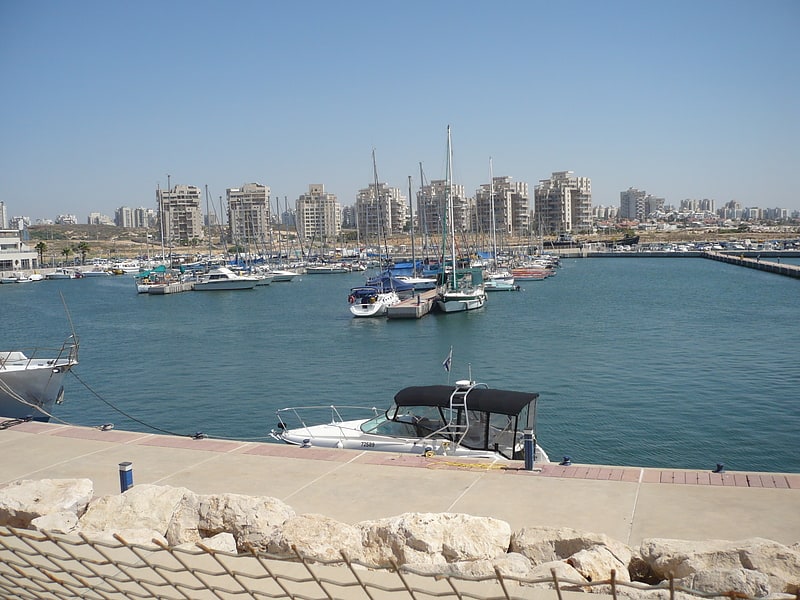
Also known as: המרינה הכחולה
Blue Marina in Ashdod is one of the newest marinas in Israel. It is located close to the city center in the middle of beach zone. The marina has berths for nearly 550 crafts. The surrounding area is being developed and will have hotels, restaurants, artificial lakes, and promenades.
The Blue Marina is a center for sea sports as well. There are surfing, sailing, and diving schools located onsite.[29]
Church of the Multiplication, Tabgha
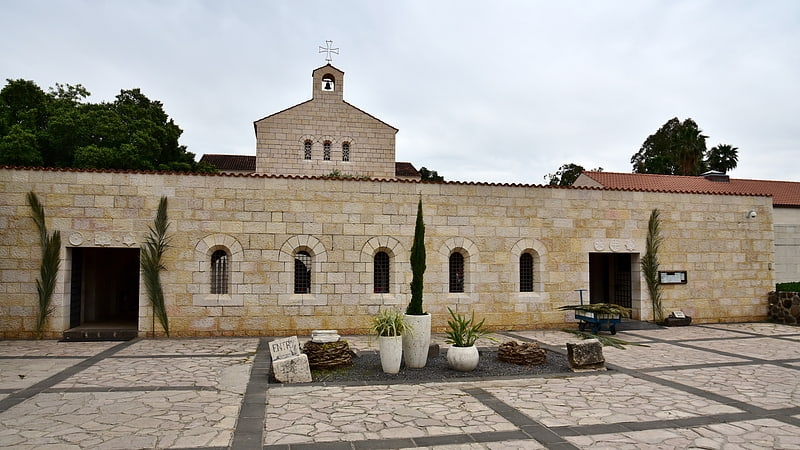
Also known as: כנסיית הלחם והדגים
Catholic church in Tabgha, Israel. The Church of the Multiplication of the Loaves and Fish, shortened to the Church of the Multiplication, is a Roman Catholic church located at Tabgha, on the northwest shore of the Sea of Galilee in Israel. The modern church rests on the site of two earlier churches.[30]
Church of the Beatitudes, Tabgha

Also known as: כנסיית הר האושר
The Church of the Beatitudes is a Roman Catholic church located on the Mount of Beatitudes by the Sea of Galilee near Tabgha and Capernaum in Israel.[31]
St. Peter's Church, Tiberias
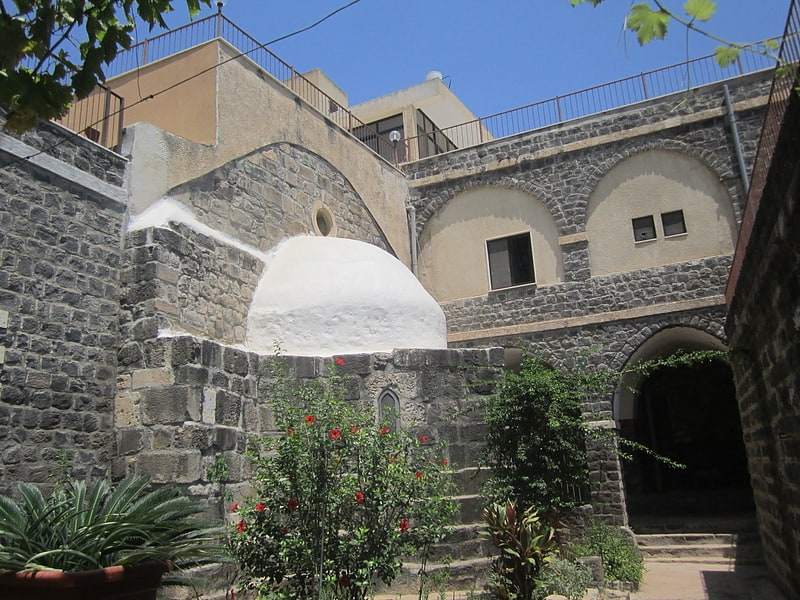
Also known as: כנסיית פטרוס הקדוש
Religious building in Tiberias, Israel. The St. Peter's Church is a religious building belonging to the Catholic Church which is next to a monastery in Tiberias, a town on the western shore of the Sea of Galilee, in the Lower Galilee, in northern District of Israel. The church is named after St. Peter one of the apostles of Jesus, because it is near where Catholics believe that St. Peter was a fisherman in Galilee.
The church was founded in the early twelfth century by the Crusaders. With the conquest of Tiberias by Muslims after the defeat of Christians in the Battle of Hattin in 1187 it became a mosque.
During the eighteenth century, the interest of the members of the Franciscan order in the church, began to visit her, first at the feast of St. Peter, and then permanently renewed. During this century the Franciscans retook control of the church. In 1833 he was brought a replica of the statue of St. Peter by Arnolfo di Cambio an exact replica of the one that exists in the Vatican, and in 1847 established a monastery near the church. In 1870 the current facade of the temple was built. After World War II was built a memorial wall depicting various issues related to the Catholic Church in Poland and the central image of the Black Madonna of Czestochowa.[32]
Oak of Mamre, Hebron
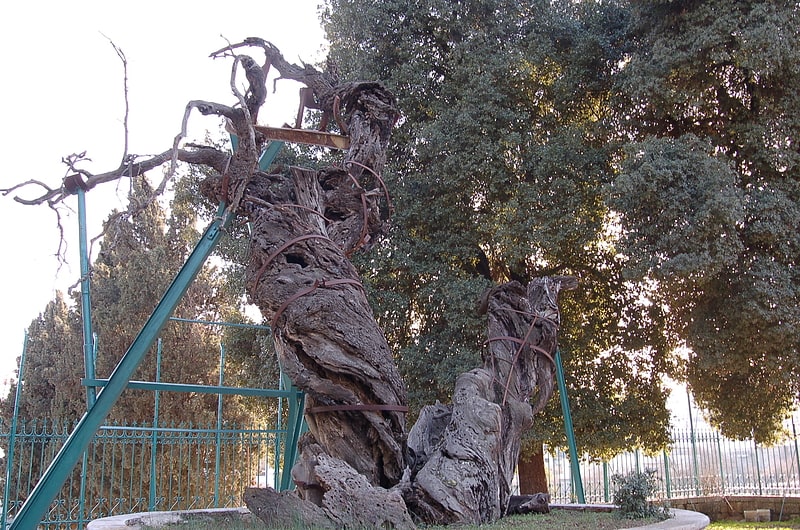
Also known as: אשל אברהם
The Oak of Mamre, at Khirbet es-Sibte, in Hebron in the West Bank is a site venerated by some as the "Oak of Abraham". It is distinct from the more ancient site of Mamre. It owes its name to an ancient tree, which seems to be dead but has a young sprig growing next to it, and stands on the grounds of the modern Russian Orthodox Monastery of the Holy Trinity.
The old tree fell in 2019, but there are plans to preserve its trunk and sustain the growth of the young shoot.
The site is located two kilometres (1.2 miles) southwest of Mamre, historically near Hebron and now inside the city. Also called The Oak of Abraham, it is an ancient oak tree (Quercus coccifera) which, in one tradition, is said to mark the place where Abraham entertained the three angels or where Abraham pitched his tent.[33]
Abraham's Well, Beer Sheva
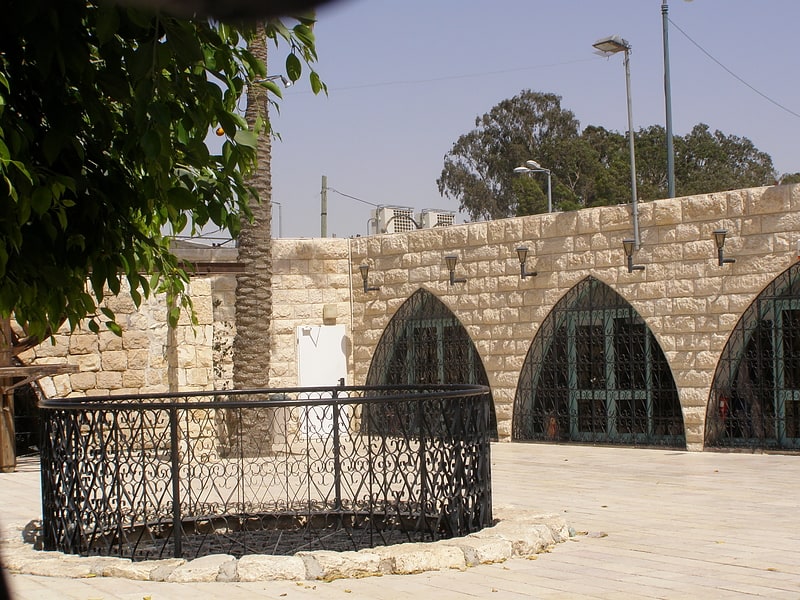
Also known as: באר אברהם
Museum in Beersheba, Israel. Abraham's Well is a historical water well in Beersheba, Israel, associated with the biblical narrative of Abraham. Its structure houses the archaeology museum of Beersheba.[34]
Address: Dereh Hevron 2, 8424400 Beersheba
Beit Jimal, Beit Shemesh
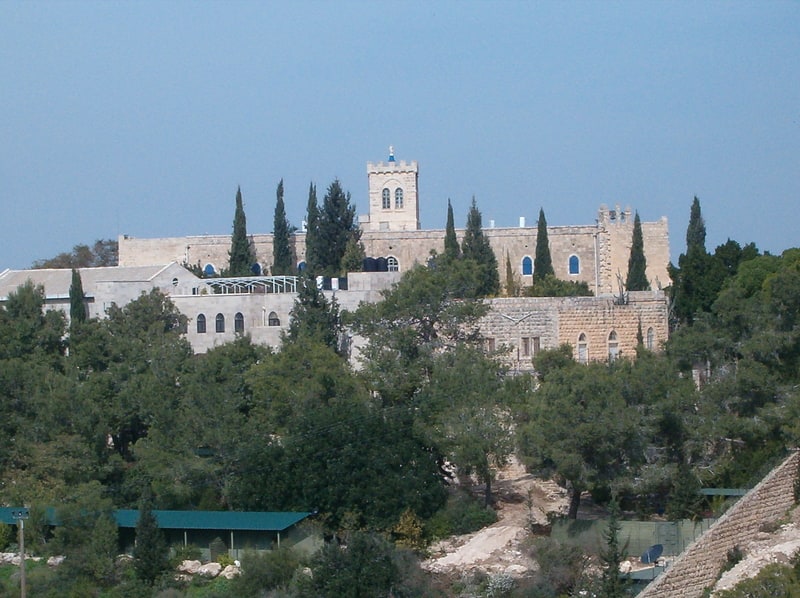
Also known as: בית ג'מאל
Monastery in Beit Shemesh, Israel. Beit Jimal, Beit el Jemâl, meaning "The house of the camel" is a Catholic monastery run by Salesian priests and brothers near Beit Shemesh, Israel. The Christian tradition identifies the site with the Roman- and Byzantine-era Jewish village of Caphargamala, and believe that a cave there is the tomb of St. Stephen or to have conserved his relics. An alternative spelling and etymology for the name is therefore Beit Gemal or Beit Gamal - the House of Rabban Gamaliel the Elder.[35]
Sheikh Ali al-Bakka Mosque, Hebron
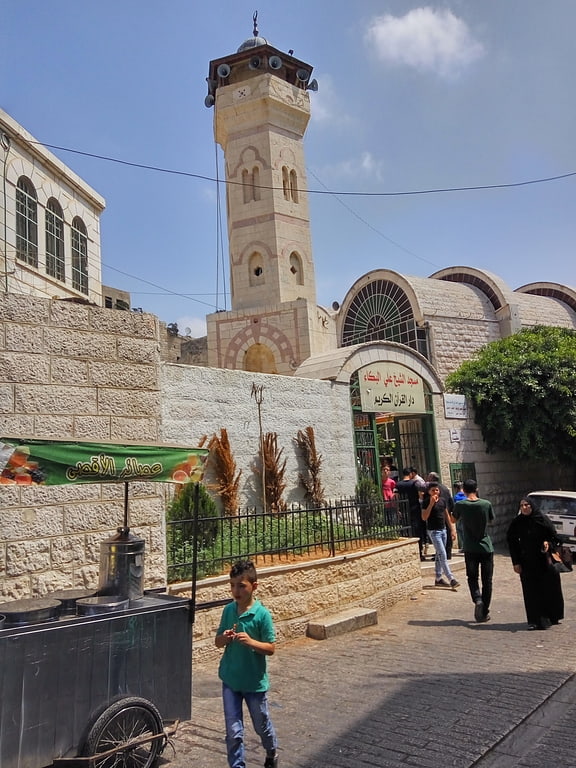
Sheikh Ali al-Bakka Mosque or Shaykh Ali al-Baka Mosque is a 13th-century mosque in the northwestern section of the Old City of Hebron in the southern West Bank. It is situated in the Harat ash-Sheikh quarter, one of the Old City's quarters, which is named after the mosque.
The mosque was founded by the Husam ad-Din Turuntay in 1282 during the reign of Mamluk sultan al-Mansur Qalawun. Turuntay was the representative of the sultan in Jerusalem. The sanctuary is named after Sheikh Ali al-Bakka, a renowned Sufi religious leader from Iraq who lived in Hebron. The minaret was erected by the viceroy and practical strongman of the sultanate, Sayf al-Din Salar (d. 1310).
The original mosque was mostly demolished, however the minaret still stands and is viewed as an exemplary work of Mamluk architecture. Sitting on a rectangular base, its shaft has a hexagonal shape. The minaret base has an arched corridor which leads to the courtyard. In 1978 a new mosque was built on the site, but preserved the remains of the original mosque.[36]
Apollonia–Arsuf, Herzliya
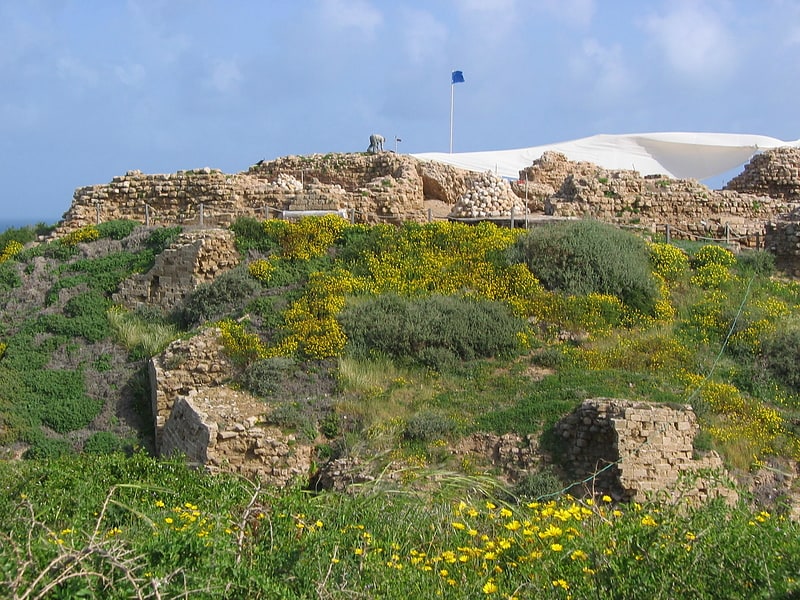
Also known as: אפולוניה
City. Apollonia, known in the Early Islamic period as Arsuf and in the Crusader Kingdom of Jerusalem as Arsur, was an ancient city on the Mediterranean coast of what is today Israel. In Israeli archaeology it is known as Tel Arshaf. Founded by the Phoenicians during the Persian period in the late sixth century BCE, it was inhabited continuously until the Crusader period, through the Hellenistic, Roman, and Byzantine periods, during the latter being renamed to Sozusa. It was situated on a sandy area ending towards the sea with a cliff, about 34 kilometres south of Caesarea.
It fell to the Muslims in 640, was fortified against Byzantine attacks and became known as Arsuf. In 1101 it was conquered by the Kingdom of Jerusalem, and was a strategically important stronghold in the Third Crusade, during which the Battle of Arsuf (1191) was fought nearby. The fortified city and the castle fell to the Mamluks in 1265, when both were completely destroyed.
The site of Arsuf (also Apollonia–Arsuf אַפּוֹלוֹנְיָה-אַרְסוּף) is now in Herzliya municipality, Israel (just north of Tel Aviv). The site was intensively excavated from 1994. In 2002 Apollonia National Park was opened to the public.[37]
Church of the Primacy of Saint Peter, Tabgha
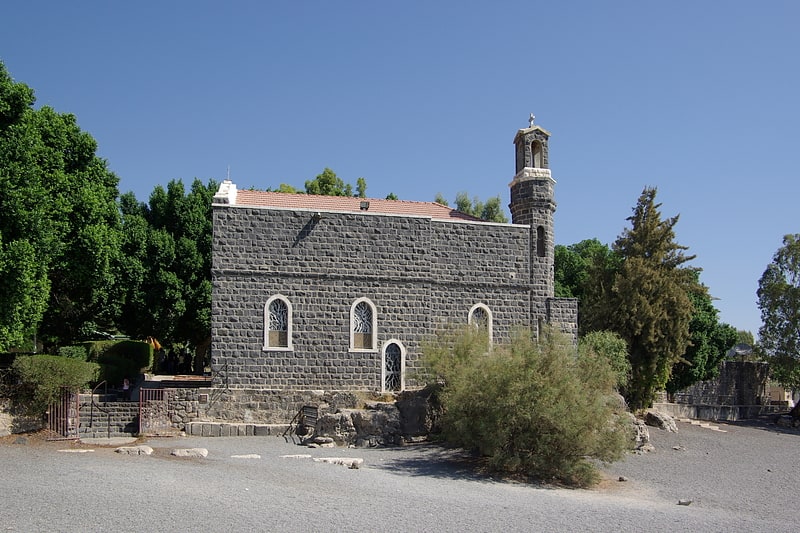
Also known as: כנסיית הבכורה של פטרוס
Church connected with a miracle of Jesus. The Church of the Primacy of Saint Peter is a Franciscan church located in Tabgha, Israel, on the northwest shore of the Sea of Galilee. It commemorates, and allegedly marks the spot, of Jesus' reinstatement of Peter as chief among the Apostles.[38]
Address: Highway 87, Tabgha
Deir Hajla, Jericho
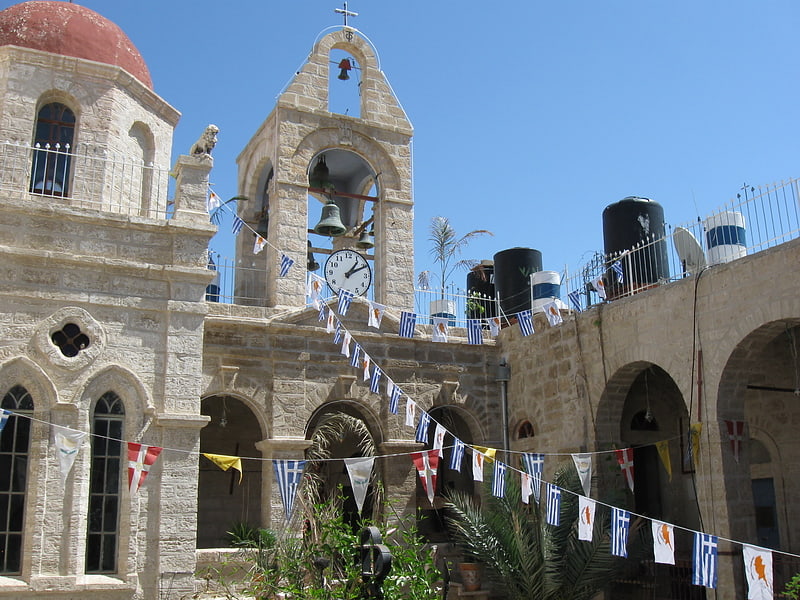
Deir Hajla or Deir Hijleh is the Arabic name of the Greek Orthodox Monastery of Saint Gerasimus. It is located in the Jericho Governorate in the West Bank, west of the River Jordan and north of the Dead Sea.[39]
Khalil Sakakini Cultural Center, Ramallah
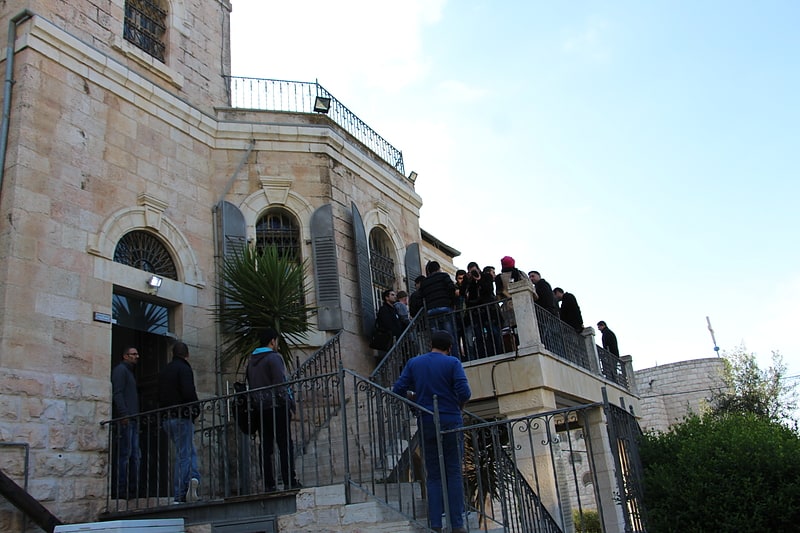
Khalil Sakakini Cultural Center is a leading Palestinian arts and culture organization that aims to create a pluralistic, critical liberating culture through research, query, and participation, and that provides an open space for the community to produce vibrant and liberating cultural content. Located in Ramallah, KSCC is housed in a renovated building, dating back to the early 20th century, based on traditional Palestinian architecture. Initially established in May 1996 as a branch of the Palestinian Ministry of Culture, KSCC was registered as a non-profit non-governmental organization in 1998. The center is named after the Jerusalemite scholar, poet, and nationalist, Khalil Sakakini.
The centre holds art exhibits, book readings, poetry readings, children's activities and film screenings. Additionally to long term projects KSCC has also transferred some of its activities to facilities outside Ramallah, such as to Birzeit, Gaza City, and Bethlehem, to enable continuation of the projects during Israeli imposed curfews.
Adila Laidi was the first director of the centre between 1996 and 2005. Yazan Khalili has been the director since 2015.[40]
Address: Khalil Sakakini Str. Al Masyoon Ramallah Palestine, Ramallah
Antipatris, Petah Tikva
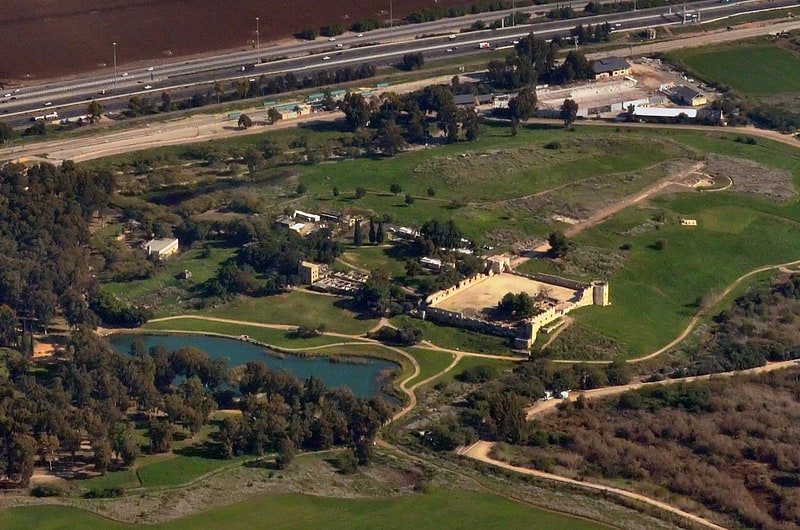
Also known as: תל אפק
Archaeological site and lookout point. Antipatris was a city built during the first century BC by Herod the Great, who named it in honour of his father, Antipater. The site, now a national park in central Israel, was inhabited from the Chalcolithic Period to the late Roman Period. The remains of Antipatris are known today as Tel Afek, although formerly as Kŭlat Râs el 'Ain. It has been identified as either the tower of Aphek mentioned by Josephus, or the biblical Aphek, best known from the story of the Battle of Aphek. During the Crusader Period the site was known as Surdi fontes, "Silent springs". The Ottoman fortress known as Binar Bashi or Ras al-Ayn was built there in the 16th century.
Antipatris/Tel Afek lies at the strong perennial springs of the Yarkon River, which throughout history has created an obstacle between the hill country to the east and the Mediterranean to the west, forcing travellers and armies to pass through the narrow pass between the springs and the foothills of Samaria. This gave the location of Antipatris/Tel Afek its strategic importance.
Antipatris was situated on the Roman road from Caesarea Maritima to Jerusalem, north of the town of Lydda where the road turned eastwards towards Jerusalem. During the British Mandate, a water pumping station was built there to channel water from the Yarkon to Jerusalem.
Today the remains of Antipatris are located roughly between Petah Tikva and the towns of Kafr Qasim and Rosh HaAyin (literally "headspring"), south of Hod HaSharon.[41]
Hisham's Palace, Jericho
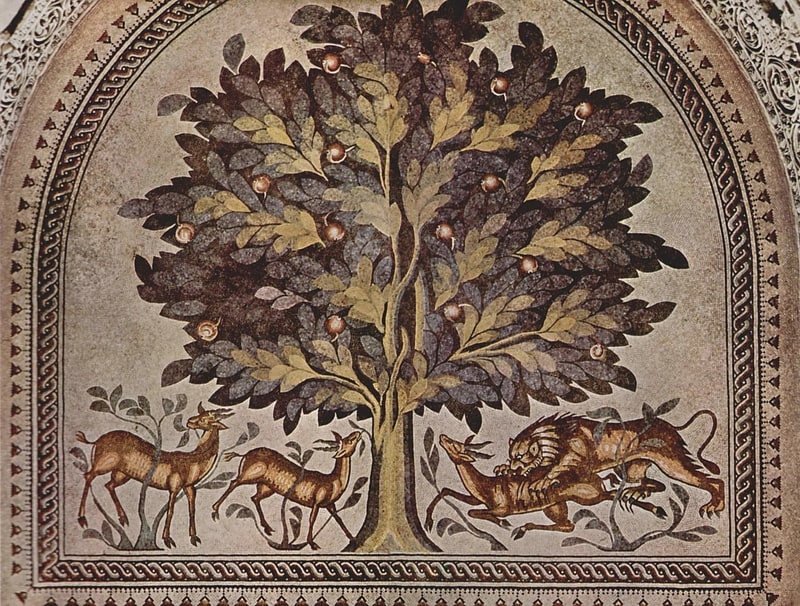
Also known as: ח'רבת אל-מפג'ר
Hisham's Palace is an important early Islamic archaeological site of the Umayyad dynasty from the first half of the 8th century, one of the so-called Umayyad desert castles. It is located at Khirbat al-Mafjar, 5 km north of the town of Jericho, West Bank.
Spreading over 60 hectares (150 acres), the site consists of three main parts: a palace, an ornate bath complex, and an agricultural estate. Also associated with the site is a large park or agricultural enclosure (ḥayr) which extends east of the palace. An elaborate irrigation system provided the complex with water from nearby springs.[42]
Address: Hisham's Palace Road, Jericho
Great Synagogue, Petah Tikva

Also known as: בית הכנסת הגדול
Synagogue in Petah Tikva, Israel. The Great Synagogue of Petah Tikva, is the city's central synagogue and located on Hovevei Zion Street, in the centre of Petah Tikva, Israel. The building was designed by Daniel HaCohen Lifshitz, one of the pioneering residents of the city and is named after James Mayer de Rothschild, the father of the Baron Edmond James de Rothschild.[43]
Mount Gerizim, Nablus
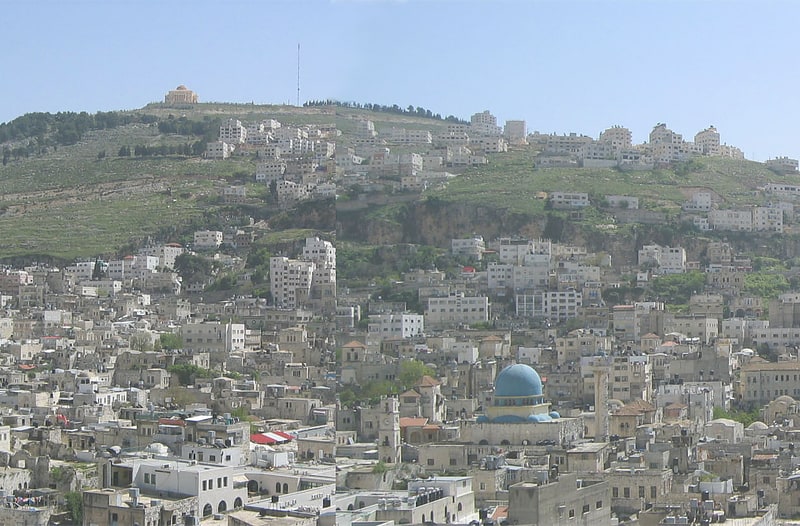
Also known as: הר גריזים
Mountain in Asia. Mount Gerizim is one of two mountains in the immediate vicinity of the West Bank city of Nablus and biblical Shechem. It forms the southern side of the valley in which Nablus is situated, the northern side being formed by Mount Ebal. The mountain is one of the highest peaks in the West Bank and rises to 881 m above sea level, 70 m lower than Mount Ebal. The mountain is particularly steep on the northern side, is sparsely covered at the top with shrubbery, and lower down there is a spring with a high yield of fresh water. For the Samaritan people, most of whom live around it, Mount Gerizim is considered the holiest place on Earth.
The mountain is mentioned in the Bible as the place where, upon first entering the Promised Land after the Exodus, the Israelites performed ceremonies of blessings, as they had been instructed by Moses.
Mount Gerizim is sacred to the Samaritans, who regard it, rather than Jerusalem's Temple Mount, as the location chosen by Yahweh (God) for a holy temple. In Samaritan tradition, it is the oldest and most central mountain in the world, towering above the Great Flood and providing the first land for Noah’s disembarkation. It is also the location where Abraham almost sacrificed his son Isaac. Jews, on the other hand, consider the location of the near-sacrifice to be Mount Moriah, traditionally identified by them with the Temple Mount. Mount Gerizim continues to be the centre of Samaritan religion to this day, and Samaritans ascend it three times a year: in Passover, Shavuot and Sukkot. Passover is still celebrated by the Samaritans with a lamb sacrifice on Mount Gerizim. Today, most Samaritans live in close proximity to Gerizim, mostly in the small village of Kiryat Luza.
The Samaritan village of Kiryat Luza and an Israeli settlement, Har Brakha, are situated on the ridge of Mount Gerizim.[44]
Mount of Temptation, Jericho
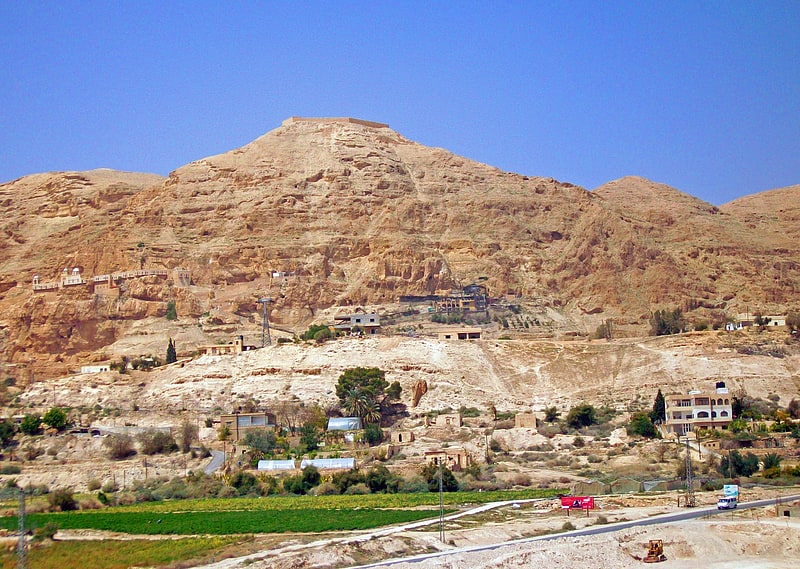
Also known as: קרנטל
Hill in Asia. The Mount of Temptation is said to be the hill in the Judean Desert where Jesus was tempted by the devil.[45]
Ashdod Museum of Art, Ashdod
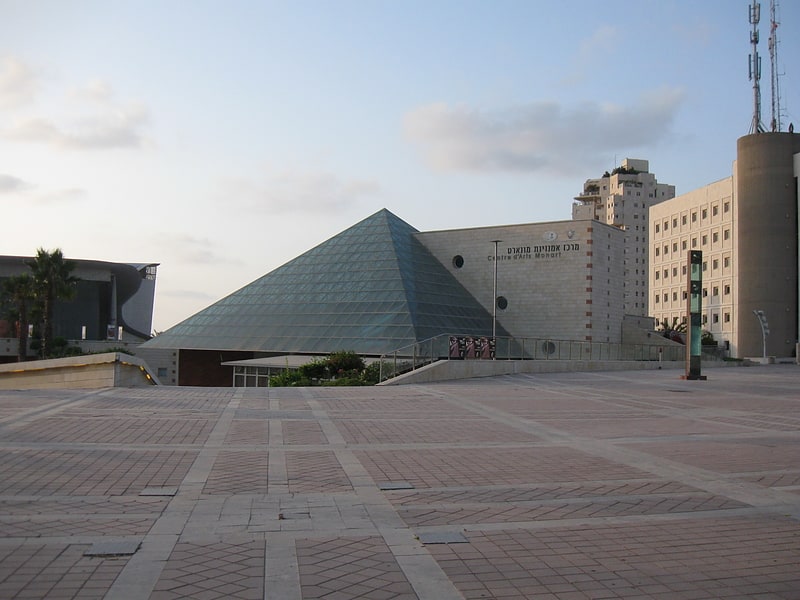
Also known as: מוזיאון אשדוד לאמנות
Museum in Ashdod, Israel. The Ashdod Museum of Art is located in the center of Ashdod, Israel, near the marina. The museum holds exhibitions of Israeli and international contemporary art. The museum has 12 galleries and two halls. In addition, it has a pyramidal space where cultural events are held. The museum was inaugurated in 2003. The museum was officially recognized by the State of Israel only in 2009.
One of museum's galleries – the Mishbetzet gallery – usually hosts original works by Israeli artists for children's education purposes. The visitors are encouraged to study works of art, including touching them. The Green Submarine gallery is dedicated to environmental art. The works exhibited in this gallery are made from recycled materials and readymades.
The Ashdod Museum of Art is also known for having an underground vault for protecting art in case of rocket attacks. This vault was used during the 2014 Israel–Gaza conflict to protect works of the Israeli artist Tsibi Geva.[46]
Address: 8 Derech Eretz, Ashdod
Sidna Ali Mosque, Herzliya

Also known as: סידנא עלי
Mosque in Herzliya, Israel. The Sidna 'Ali Mosque is a mosque located in the depopulated village of Al-Haram on the beach in the northern part of Herzliya in Israel. It served, as of 1998, as both a mosque and a religious school.
The mosque is situated around a tomb reputed to be that of a local saint, Ali b. Alim who died in 1081. Ali was described as great scholar and miracle worker by Sultan Baybars' biographer, Muhyi al-Din (died 1292). According to Mujir al-Din (writing c. 1496), the tomb was visited by Baybars in 1265. Baybars prayed for victory before retaking Arsuf from the crusaders. An annual festival that was attested here in the 15th century continued up to the 1940s.
The existing building contains parts of different ages of construction and repair, however Petersen claims that none from before the 15th century, while Taragan identifies elements, specifically the entrance door to the minaret, which fit the style of other early Mamluk religious buildings from the 1270s-90s, noting though that no written documents remain to support such an early date for the mosque. The part of the building described as the oldest in 1950 has since disappeared. Taragan places the construction of the vaulted arcades to sometime between the thirteenth and fifteenth centuries, with important additions made in the late 15th century, including the well, a marble monument on the tomb and an unidentified tower. The rooms on the second floor and the inscription now placed opposite the mihrab were added. The minaret was destroyed by naval bombardment in World War I and since rebuilt. Major repair work was done in 1926, the 1950s and 1991–1992.
Since 1990, not least due to its central location in Israel, the shrine is again a popular target for pilgrimage for Israeli Arabs from the villages of the Galilee and townspeople from places like Jaffa and Ramla, coming on Fridays to pray at the tomb and participate in different ceremonies.[47]
Al-Kasaba Theatre, Ramallah
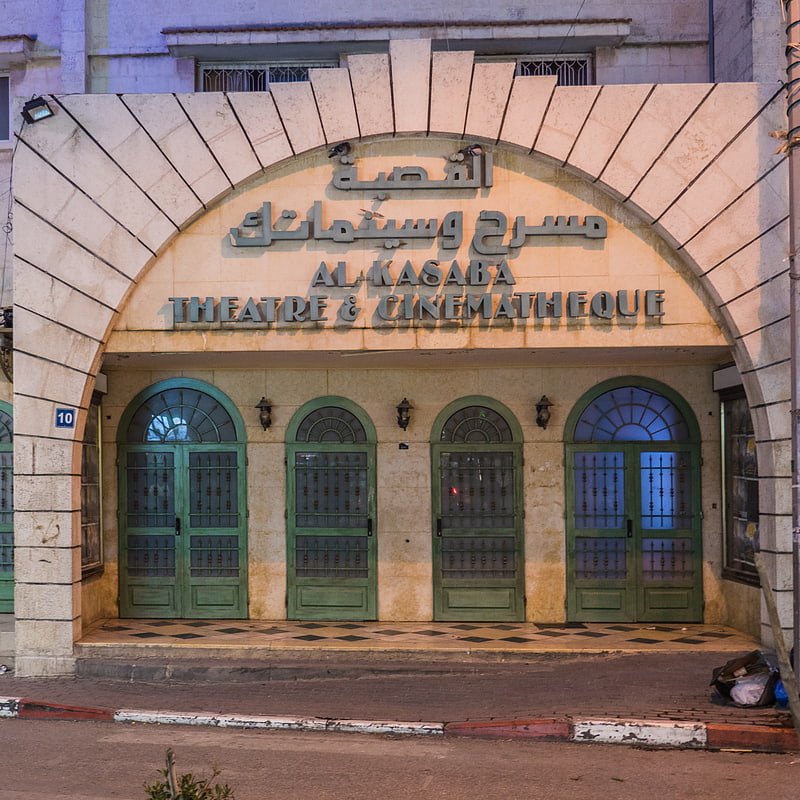
Also known as: תיאטרון אל-קאסבה
Theatre. Al-Kasaba Theatre and Cinematheque is a cinema in the city of Ramallah, West Bank, Palestine. It was established in 1970 during Israeli occupation for playwrights and eventually began presenting films. Al-Kasaba is the only official multipurpose cinema in the Palestinian territories.[48]
Jacob's Well, Nablus
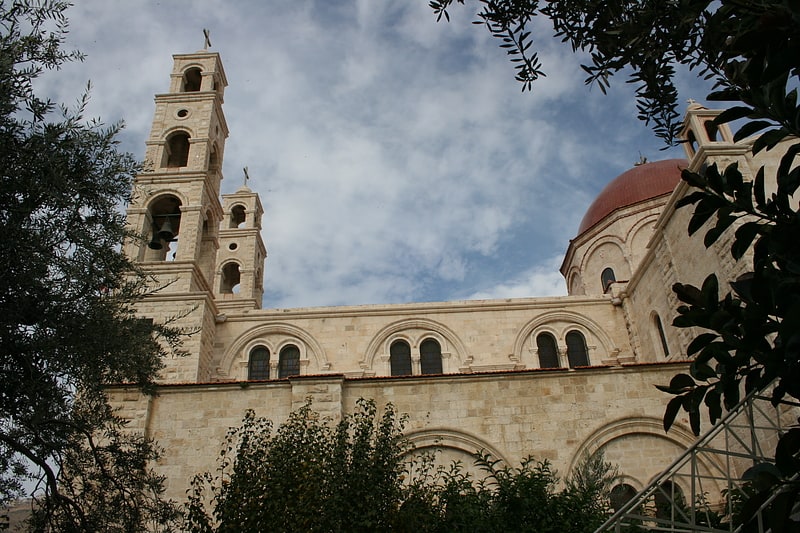
Also known as: באר יעקב
Religious destination. Jacob's Well is a deep well constructed from rock that has been associated in religious tradition with Jacob for roughly two millennia. It is situated inside an Eastern Orthodox church and monastery, in Balata village on the outskirts of the Palestinian city of Nablus in the West Bank.[49]
Jamal Abdel Nasser Mosque, Ramallah
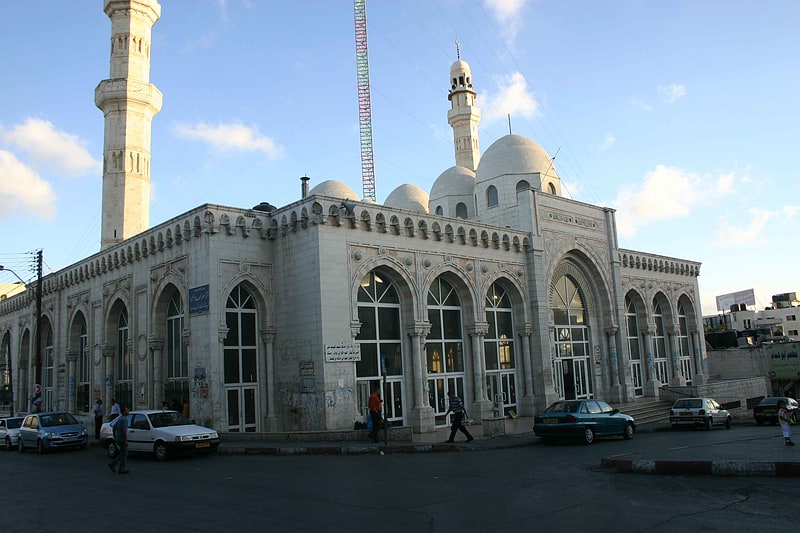
Mosque. Jamal Abdel Nasser Mosque is the largest mosque in al-Bireh, West Bank, Palestine. Located in the Downtown district of the city, the mosque is named after the late Egyptian president and Arab leader Gamal Abdel Nasser.
On March 14, 2002, the Israeli Army (IDF) took over the mosque and used its minaret for sniping, killing four Palestinians.
On September 22, 2007, dozens of wives of Hamas-affiliated political prisoners and other female Hamas members marched from the Jamal Abdel Nasser Mosque to Al-Manara Square in protest of what they saw as the politically motivated detentions of their relatives by the Palestinian Authority (PA). They were prevented from reaching the square when PA security forces used tear gas to disperse them.[50]